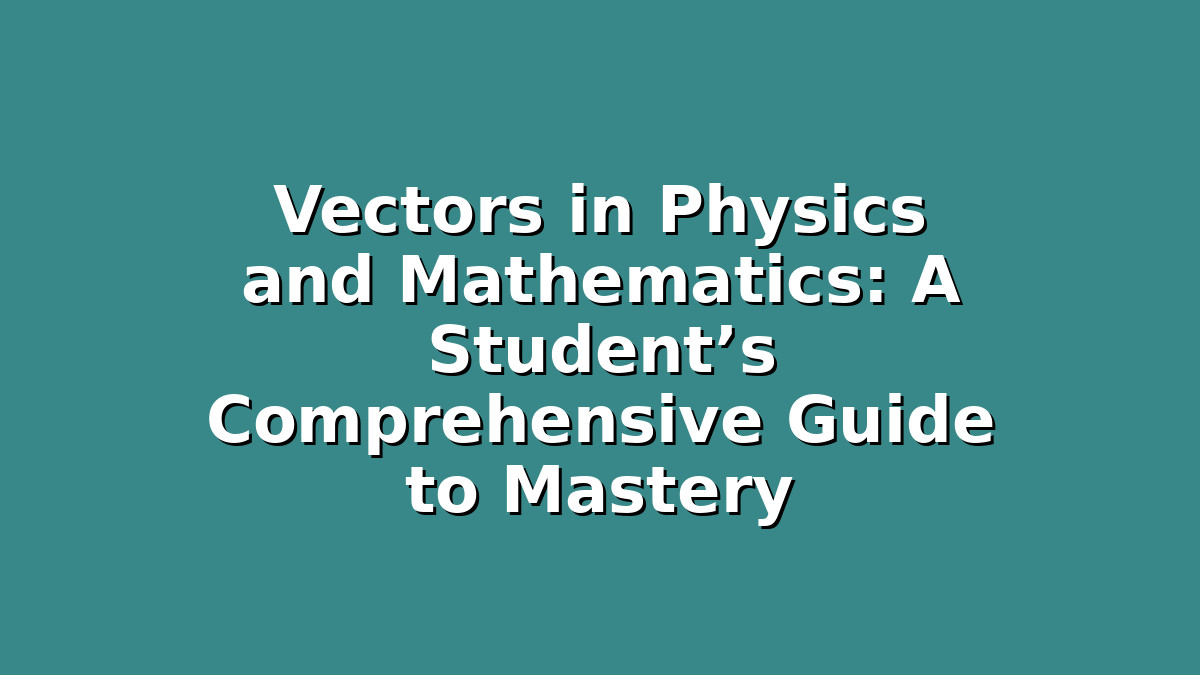Introduction
If you’re a student preparing for exams in physics or mathematics, you’ve likely encountered the concept of vectors. Whether you’re calculating forces, displacements, or working with coordinate systems, understanding vectors is essential. Vectors are not just abstract notions; they are powerful tools that describe quantities having both magnitude and direction, making them crucial in fields ranging from engineering to computer graphics.
This comprehensive guide will help you grasp vectors deeply, improve your study techniques, and boost your confidence for exams. We’ll explore what vectors are, how to work with them, and share effective study strategies tailored to mastering vectors in physics and mathematics.
Section 1: Understanding the Fundamentals of Vectors
To build a strong foundation, it’s important to fully understand what vectors represent and how they differ from scalar quantities.
1.1 What Are Vectors?
A vector is a quantity defined by two key properties:
– Magnitude: The size or length of the vector.
– Direction: The orientation in space.
Examples of vectors include displacement, velocity, acceleration, and force. In contrast, scalars have only magnitude, such as temperature or mass.
1.2 Representing Vectors
Vectors are often represented graphically by arrows. The length of the arrow corresponds to the magnitude, and the arrow points in the direction of the vector.
In mathematical terms, vectors in two or three dimensions are written as ordered pairs or triplets, like v = (x, y) or v = (x, y, z), where x, y, and z represent components along the respective axes.
1.3 Key Vector Operations
– Addition: Combining vectors by adding their components.
– Subtraction: Finding the difference between vectors.
– Scalar Multiplication: Scaling a vector’s magnitude without changing direction.
– Dot Product: Produces a scalar, useful for finding angles or projections.
– Cross Product (in 3D): Results in a vector perpendicular to the original two, important in physics for torque and rotational motion.
Study Tip: Use Visual Aids
Drawing vectors and their operations can dramatically improve your understanding. When studying, sketch vectors on graph paper to see how they add or subtract. Visual learning helps reinforce abstract concepts.
Section 2: Applying Vectors in Physics and Mathematics Problems
Vectors are used extensively in both physics and math problems, often requiring problem-solving skills beyond just calculation.
2.1 Vectors in Physics
In physics, vectors describe quantities such as:
– Displacement: The change in position.
– Velocity: The rate of change of displacement.
– Force: A push or pull acting on an object.
– Acceleration: The rate of change of velocity.
Understanding vectors helps you analyze situations like projectile motion, where you separate velocity into horizontal and vertical components, or forces acting at angles.
2.2 Breaking Vectors into Components
Many problems require breaking vectors into components along the x, y (and sometimes z) axes. This simplifies calculations by turning vector problems into algebraic ones.
Example: A force of 10 N acting at 30° to the horizontal can be broken down into:
– Horizontal component = 10 × cos(30°)
– Vertical component = 10 × sin(30°)
2.3 Vectors in Mathematics
In mathematics, vectors extend beyond physics:
– Geometry: Representing points, lines, and planes.
– Linear Algebra: Vector spaces, bases, and transformations.
– Calculus: Gradient vectors and vector fields.
Study Tip: Practice with Real-Life Examples
Applying vectors to real-world problems makes learning more engaging. For example, analyze the velocity of a boat crossing a river with a current or calculate the resultant force on a beam. Practice problems from textbooks or online resources that connect theory to tangible scenarios.
Section 3: Effective Study Techniques to Master Vectors
Mastering vectors requires not only understanding concepts but also consistent practice and smart study habits.
3.1 Build Your Conceptual Framework
Before jumping into problem-solving, ensure you understand definitions, properties, and operations related to vectors. Use multiple resources such as textbooks, lecture notes, videos, and interactive simulations.
3.2 Practice Step-by-Step Problem Solving
Vectors problems can be multi-step. Develop a stepwise approach:
– Read the problem carefully.
– Draw a diagram.
– Identify known quantities.
– Break vectors into components if necessary.
– Apply vector operations.
– Solve algebraic equations.
– Check your answers for consistency and units.
3.3 Use Flashcards for Key Formulas and Definitions
Create flashcards for formulas such as vector addition rules, dot and cross products, and vector magnitude formulas. Regularly review them to reinforce memory.
3.4 Collaborate and Discuss
Study groups or online forums can be invaluable. Explaining vector concepts to peers not only helps others but deepens your own understanding.
3.5 Simulate Exam Conditions
Practice solving vector problems within timed sessions to improve speed and accuracy. This reduces exam anxiety and helps manage time effectively.
Conclusion
Vectors are a fundamental concept bridging physics and mathematics, essential for understanding many scientific and engineering principles. With clear knowledge of vector properties, applications, and operations, coupled with effective study strategies, you can approach vector problems confidently and improve your exam performance.
Remember, mastering vectors takes time and practice. Use visual aids, real-life applications, organized study methods, and collaborative learning to strengthen your skills. Keep a positive attitude, and don’t hesitate to seek help when needed. With dedication and the right approach, vectors will become an area of strength in your academic journey.

Responses